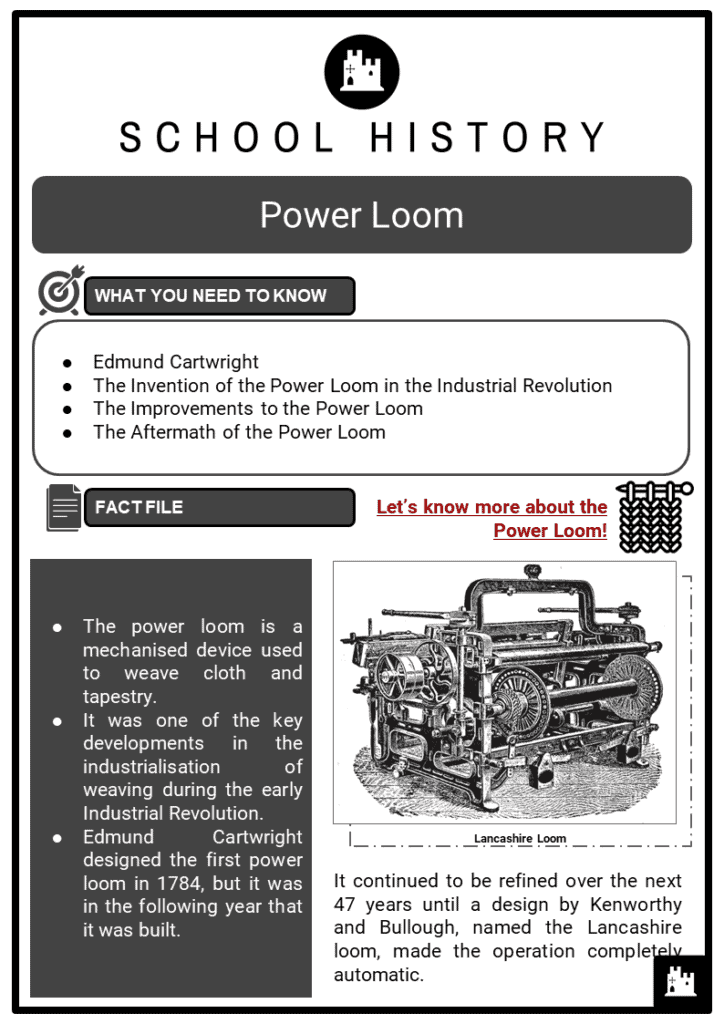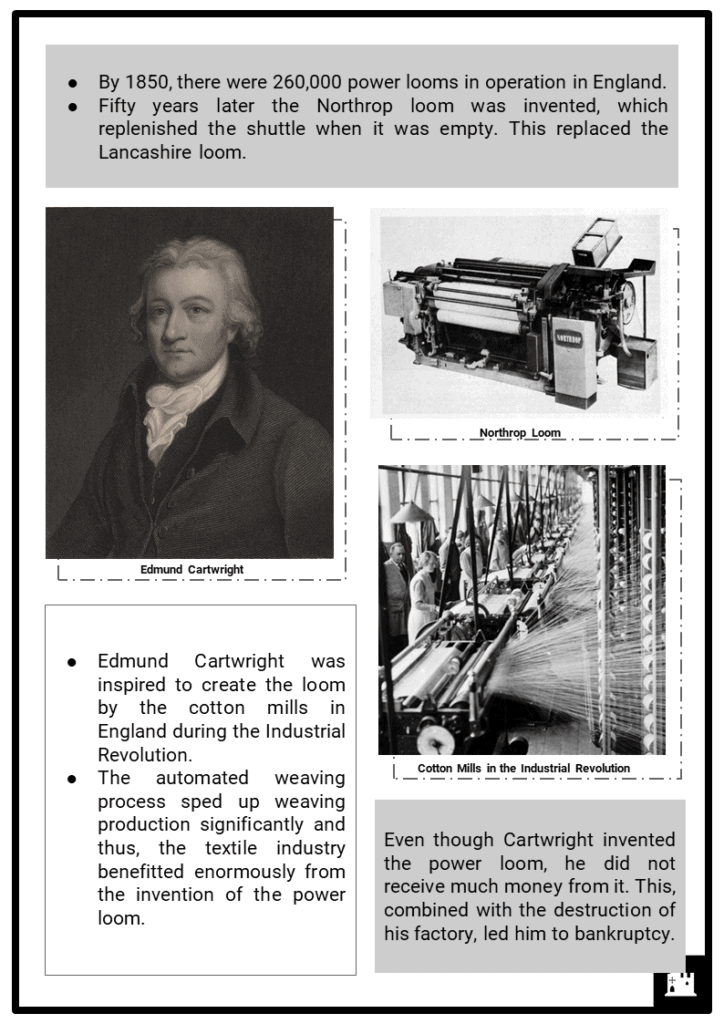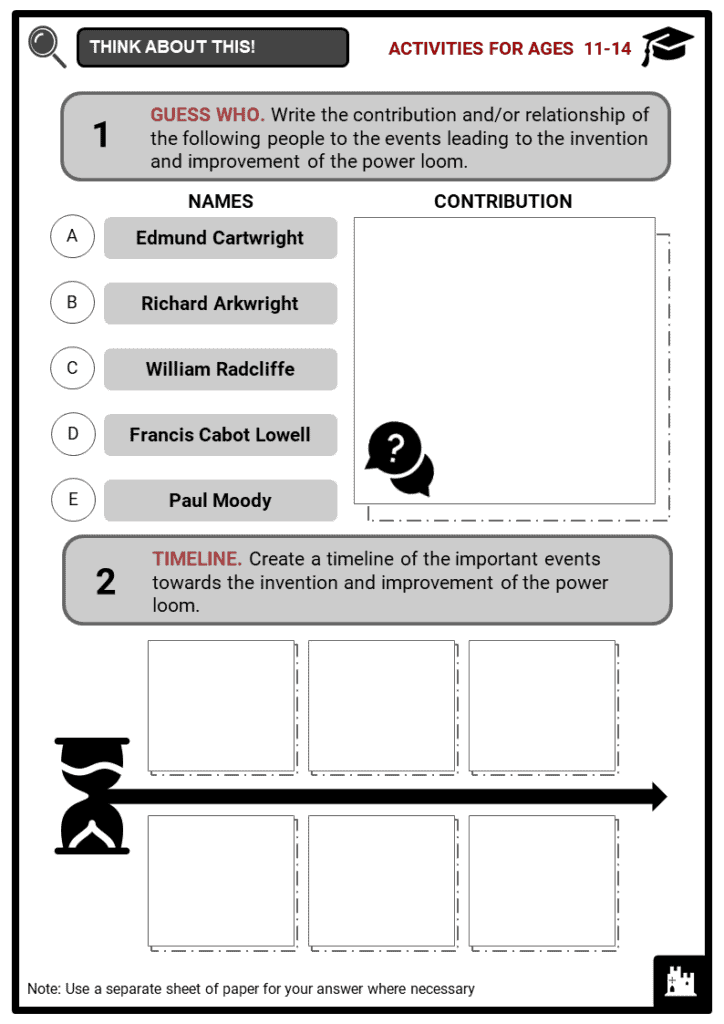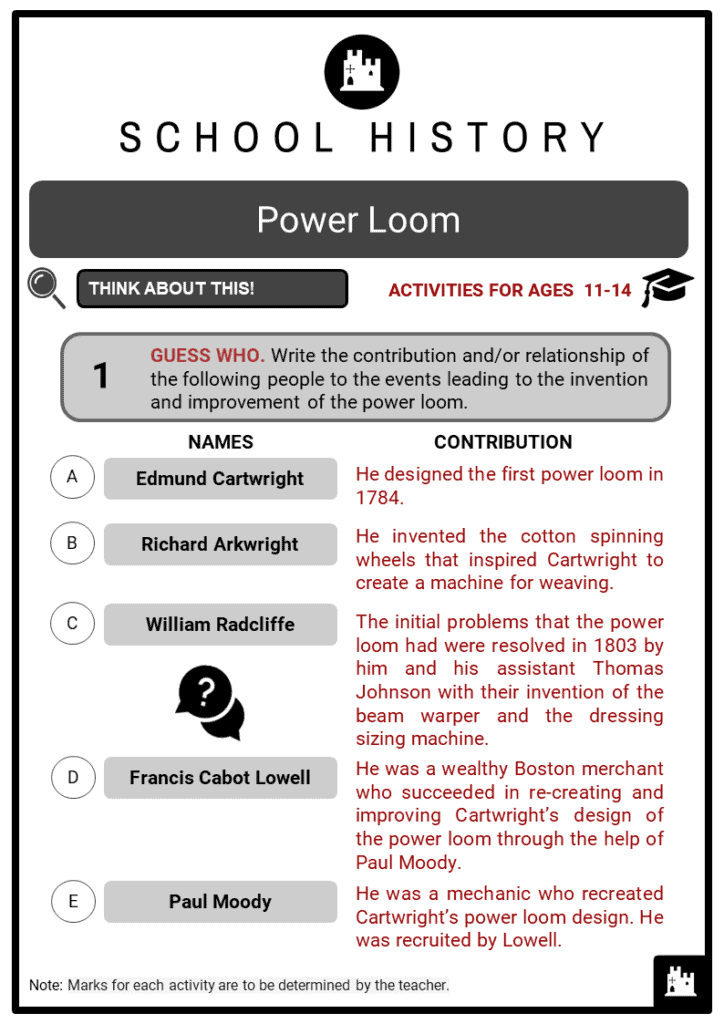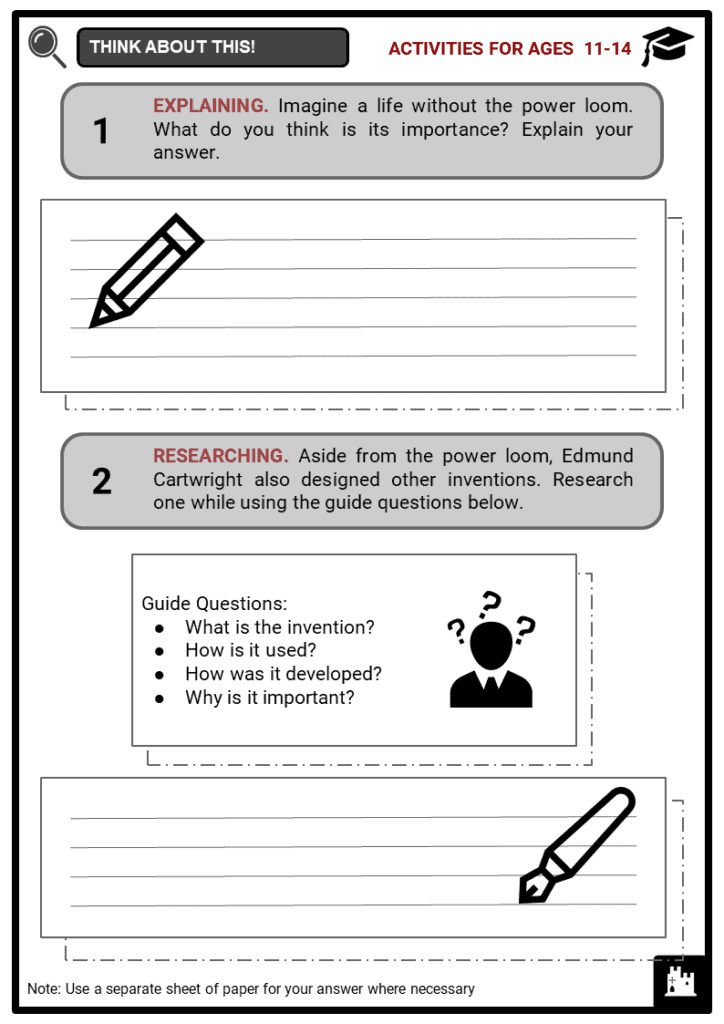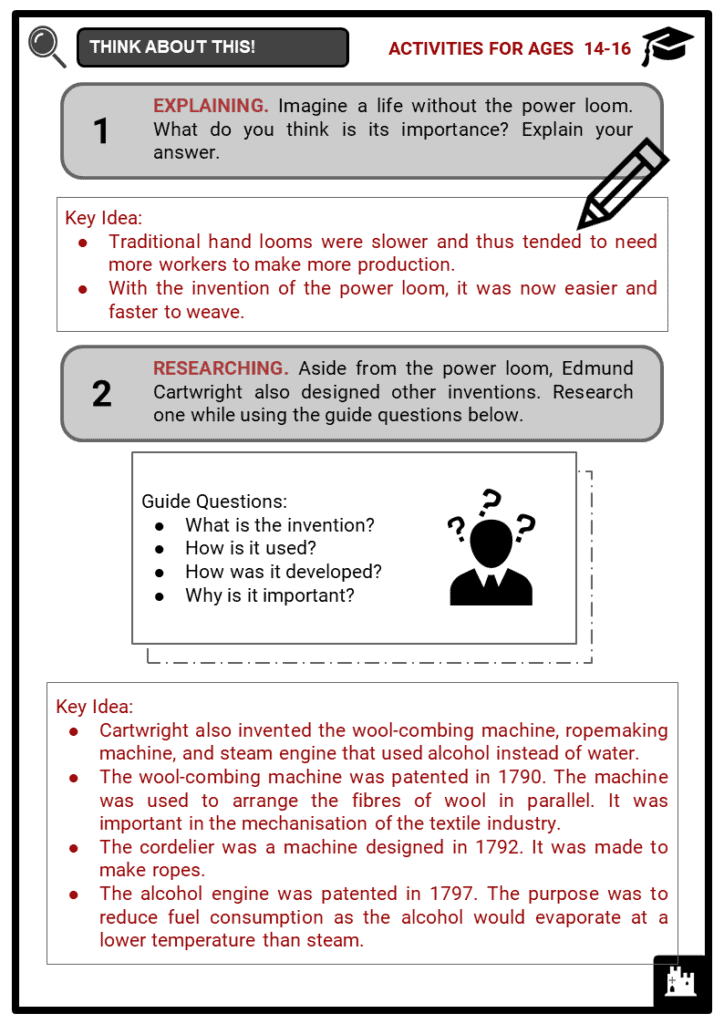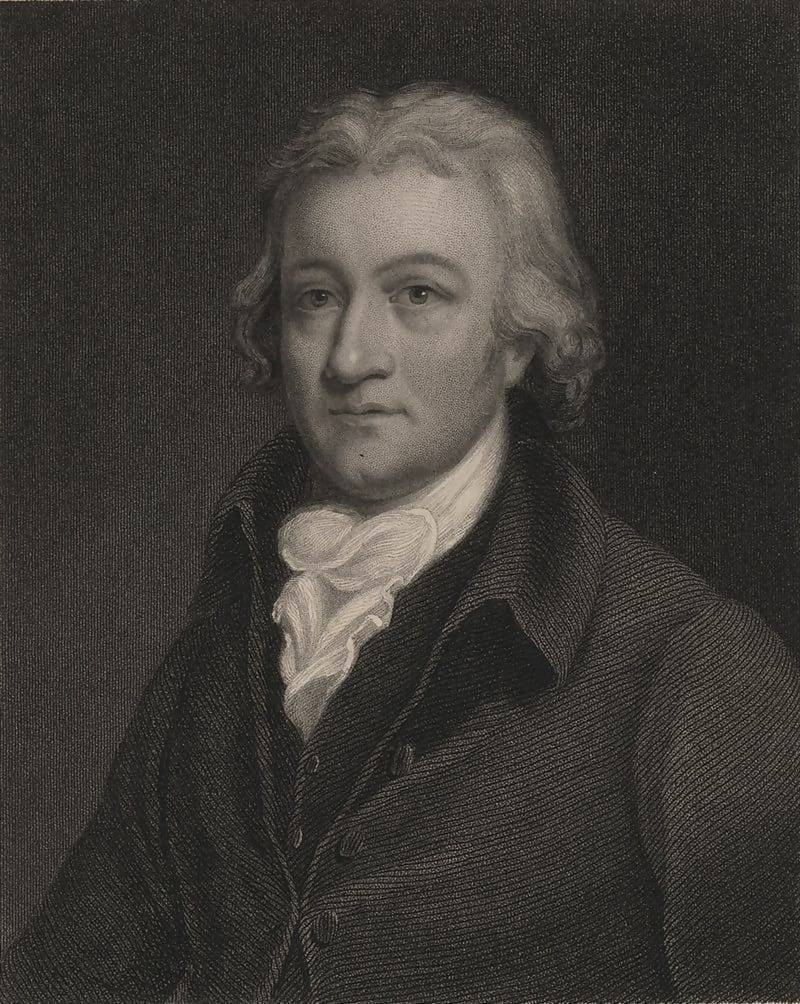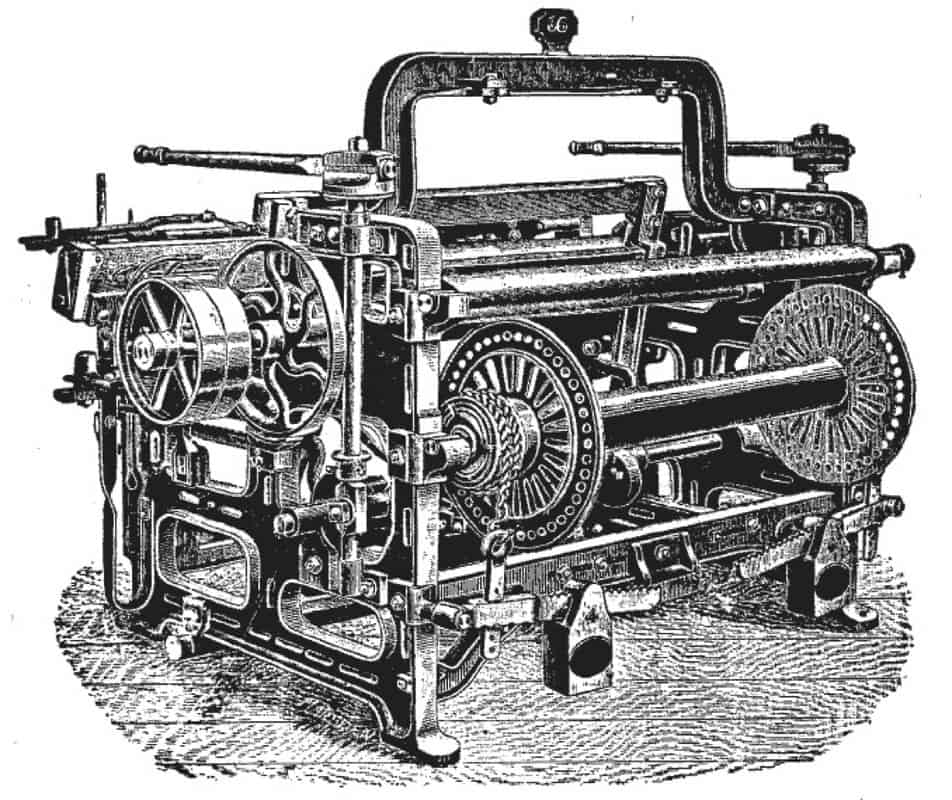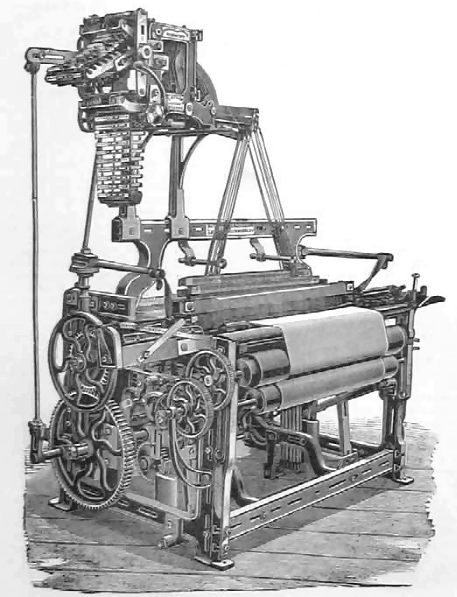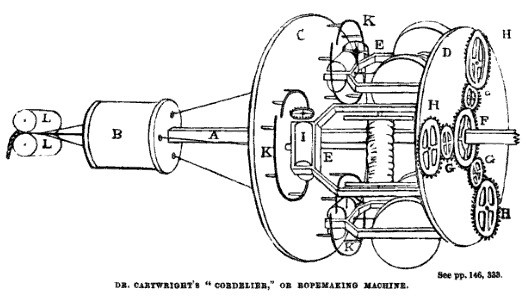Download Power Loom Worksheets
Do you want to save dozens of hours in time? Get your evenings and weekends back? Be able to teach Power Loom to your students?
Our worksheet bundle includes a fact file and printable worksheets and student activities. Perfect for both the classroom and homeschooling!
Summary
- Edmund Cartwright
- The Invention of the Power Loom in the Industrial Revolution
- The Improvements to the Power Loom
- The Aftermath of the Power Loom
Key Facts And Information
Let’s know more about the Power Loom!
- The power loom is a mechanised device used to weave cloth and tapestry.
- It was one of the key developments in the industrialisation of weaving during the early Industrial Revolution.
- Edmund Cartwright designed the first power loom in 1784, but it was in the following year that it was built.
- It continued to be refined over the next 47 years until a design by Kenworthy and Bullough, named the Lancashire loom, made the operation completely automatic.
- By 1850, there were 260,000 power looms in operation in England.
- Fifty years later the Northrop loom was invented, which replenished the shuttle when it was empty. This replaced the Lancashire loom.
- Edmund Cartwright was inspired to create the loom by the cotton mills in England during the Industrial Revolution.
- The automated weaving process sped up weaving production significantly and thus, the textile industry benefitted enormously from the invention of the power loom.
- Even though Cartwright invented the power loom, he did not receive much money from it. This, combined with the destruction of his factory, led him to bankruptcy.
Prologue
- One of the most significant events in world history was the Industrial Revolution. It had a great impact upon what was to become the modern world.
- Before the innovations of the Industrial Revolution, most production depended on water, wind and especially human energy.
- Before factories, there were cottage industries.
- These industries comprised of many producers working from their home.
- Business operators would travel around the world to buy raw materials and deliver them to the people who would work for them.
- They then came later and collected the finished goods in order to sell or deliver them to another market.
- The people working here had both the time and desire to earn additional income especially during winter when there was little work to do.
- One of the factors which allowed the Industrial Revolution to take place in Western Europe was the presence of these business people who had the ability to expand the scale of their operations.
- However, by the mid-1700s, new methods of production were being developed across Europe, especially in Great Britain.
- This transition led to the factory system, which was the creation of factories in centralised locations such as industrial towns and cities.
- This period of innovation continued throughout the 19th century and led to many new inventions by now famous inventors.
- The Industrial Revolution led to many inventions and more automation or mechanisation.
- Some of the significant inventions or innovations included: the power loom, cotton gin, steam engine, telephone, light bulb, flying shuttle, automobile and many more!
Edmund Cartwright
- Born on 24 April, 1743, in Nottinghamshire, England, Edmund Cartwright graduated from Oxford University.
- He had four brothers who were highly accomplished. One of them named John was a naval officer who fought for political reforms. Another named George was a trader who explored Newfoundland and Labrador.
- His father was the Reverend E. Cartwright, and he followed his footsteps as he first became a clergyman.
- However, later on, he would become known as an inventor.
- He married at the age of 19 to Elizabeth McMac and they had a daughter named Elizabeth who would become an author under the pseudonym Mrs Markham.
- It is safe to assume that the accomplishments of his brothers may have had an influence upon him.
- However, his ambitions would only appear in his later years.
Power Loom
- In his 40s, Edmund Cartwright began experimenting with his inventions.
- Inspired by the cotton spinning wheels invented by Richard Arkwright while on a trip working for the church, he suddenly wished to create a machine for weaving.
- He did not have any experience in this field, however. Many people were skeptical and regarded his ideas as nonsense.
- After seeing the spinning machines, Cartwright thought that he could make something similar for weaving, an invention he would later call the power loom.
- He began working on the designs of the machine in 1784 and fully built it in 1785 with the help of a carpenter.
- Although the design was simplistic at first, he strived for and patented another loom.
- His patent served as the model for later inventors to work upon.
- He continued to make improvements to his power loom until he had developed a productive machine.
- After establishing a factory in Doncaster, he began to mass produce the machine.
- Sadly, Cartwright had no experience or knowledge in business and industry.
- He was never able to successfully market his power looms but continued to test new inventions in his factory.
- In 1789, he created a wool-combing machine but the power loom was still on his mind.
- He secured another patent for a weaving invention in 1792.
- For a mechanically driven loom to become a commercial success, either one person would have to attend one machine, or each machine must have a greater productive capacity than one manually controlled machine.
- An old man named Zach Dijkhoff assisted him in creating this contraption.
- In general, looms were used to weave together fabrics in order to create textiles.
- Cartwright did not benefit much from his invention of the power loom.
- For instance, he made very little money from his invention.
- However, it became apparent that no mechanism, however perfect, could succeed so long as warps continued to be sized while a loom was stationary. His plans for sizing them while a loom was in operation, before being placed in a loom, failed.
- Cartwright went bankrupt in 1793, forcing him to close his factory. Though he did sell around 400 of his looms to a Manchester company, he lost his remainder when the factory burned down.
- It is speculated that his workers burned down the factory because they feared that they would be put out of work due to the new power looms. Their fears were however proven to be right in the near future.
- After being bankrupt and destitute, Cartwright moved to London in 1796 and designed a steam engine that used alcohol instead of water.
- He also invented a cordelier which was a ropemaking machine.
Improvements to the Power Loom
- It was clear, however, that the power loom was Cartwright’s greatest invention.
- Even if his design had a lot of flaws, many inventors were captivated by his work and sought to take on the challenge of improving the power loom.
- The initial problems that the power loom had were resolved in 1803 by William Radcliffe and his assistant Thomas Johnson with their invention of the beam warper and the dressing sizing machine.
- The Scottish inventor William Horrocks, who was the designer of the variable speed batton, and the American inventor Francis Cabot Lowell continued to improve the power loom.
- The power loom was then commonly used after 1820. After it became efficient, women replaced most men as weavers in the textile factories.
- Even if many of Cartwright’s inventions were not successful, he would eventually be recognised by the House of Commons for the national benefits of his power loom.
- The legislators awarded the inventor a prize of 10,000 British pounds for his contributions.
- In the end, despite Cartwright’s power loom being highly influential, he received little in the way of a financial reward for it.
- Cartwright died in 1823 but two years prior to this, he was made a Fellow of the Royal Society.
Aftermath
- Many inventions of the Industrial Revolution are still in use even today.
- Though they have been improved upon or even greatly altered, their basis was created during that period of time.
- Edmund Cartwright’s invention of the power loom is no exception.
- He played a pivotal role in the evolution of textile production.
- Weaving was the last step in textile production to become mechanised.
- The main difficulty in this process was to imitate the coordination of the human hand and eye.
- Cartwright’s power loom, although flawed, managed to do this and thus, accelerated the process of manufacturing.
- In 1803, there were about 2,400 power looms in all of Britain, but by 1833, there were as many as 100,000.
- All the textile factories in Britain used them and thus the textile industry benefited enormously from the power loom.
- According to the Lowell National Historical Park Handbook, Francis Cabot Lowell, a wealthy Boston merchant, realised that in order for America to keep up with England’s textile production, where successful power looms had been in operation since the early 1800s, they would need to borrow British technology.
- He visited English textile mills and memorised the workings of their power looms which were based on Cartwright’s design.
- When Lowell returned to the United States, he recruited a mechanic named Paul Moody to help recreate what Lowell had seen.
- They succeeded and continued to make improvements to the power looms.
Image source:
[1.] https://upload.wikimedia.org/wikipedia/commons/c/c2/Edmund_Cartwright_2.jpg
[2.] https://www.historycrunch.com/uploads/4/1/1/6/41169839/power-loom-industrial-revolution_orig.jpg
[3.] https://upload.wikimedia.org/wikipedia/commons/0/02/TM158_Strong_Calico_Loom_with_Planed_Framing_and_Catlow%27s_Patent_Dobby.png
[4.] https://upload.wikimedia.org/wikipedia/commons/3/38/Cartwright_Edmund_ropemaking.jpg
[5] https://upload.wikimedia.org/wikipedia/commons/e/ea/Strickmaschine_im_Museum.JPG

